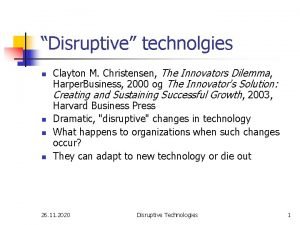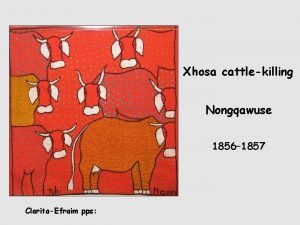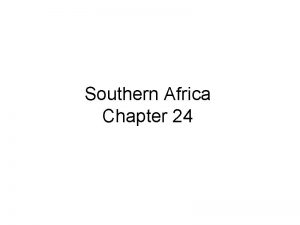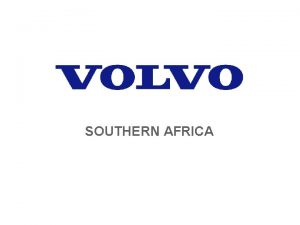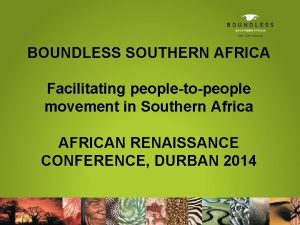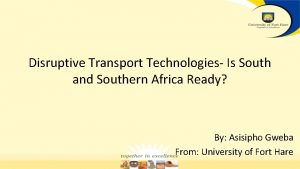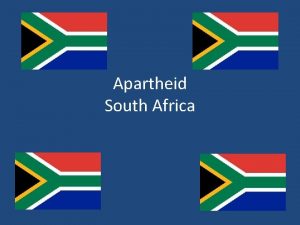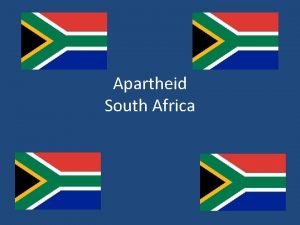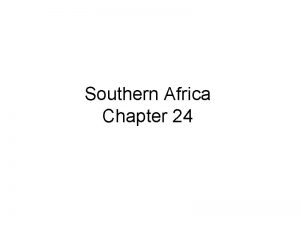DISRUPTIVE TRANSPORT TECHNOLOGIES IS SOUTH AND SOUTHERN AFRICA








- Slides: 8

DISRUPTIVE TRANSPORT TECHNOLOGIES: IS SOUTH AND SOUTHERN AFRICA READY? “Disruptors don’t have to discover something new; they just have to discover a practical use for new discoveries. ” – Jay Samit L Smith – Stellenbosch University 38 th SATC - 2019

E-hailing services Process of ordering a lift via a smart device 3 rd party intermediary facilitating transaction between riders and drivers Argued to be disruptors to the meter taxi market, by creating additional value to its commuters at the displacement of existing alternatives. Gained foothold in low end market and established new market Uber has created an estimated three-fold increase in the market size beyond the existing market of traditional metered taxis 1. A recent report from Lyft claimed that the company provided 375. 5 million rides in 2017, and that 250, 000 American passengers got rid of their cars that year specifically because of ride-share services 3 10% of millennial Uber riders within the United States halted the purchase of a private vehicle since the introduction of e-hailing services 2 Victory Research (2017)1 , Stanley (2018) 3, Henao & Marshall (2019) 2

Possible implications from existing literature Those who do not use e-hailing services own on average 1. 5 cars per household. When compared to those that do make use of the service, commuters owned 1. 05 cars per household. On average, e-hailing users own less vehicles. 4 Compliment and substitute to both private and public transport 5 6 Texas study e-hailing services were paused due to local ordinance, the results found that 41% of respondents reverted to their vehicles to fill the gap and 9% of respondents indicated that they bought an additional vehicle to meet their travel needs. 4 Silver and Fischer-Baum (2015) compared general travel cost of public transit and found that passengers who made use of Uber services in combination with high use of (65% to 85%) public transport can be significantly cheaper than car ownership. Unknown what effect it may have in South Africa. American Public Transportation Association (2016) 4, Austin & Zegras (2012) 5 , King et al. (2012) 6

Research Aim and Methodology Aim: To what extent may e-hailing services impact vehicle ownership? Convenience sample of 9 commuters using travel diaries during the week 11 th to the 16 th March 2019 Analysis was undertaken to assess the differences in commuting costs and travel times when comparing private vehicle usage and Uber usage The travel dairy logged each trips’ start time, origin, destination, distance and end time Vehicle characteristics The total vehicle operating cost for each trip was calculated by using a rate per kilometre derived from the AASA vehicle rate calculator for each participant 7 Participant travel diaries used to forecast yearly travel and compare vehicle OC & Uber fares Automobile Assocation of South Africa (2019) 7

Travel diary information and forecasts Participant 1 Participant 2 Participant 3 Participant 4 Participant 5 Participant 6 Participant 7 Participant 8 Participant 9 Weekly distance (km) Projected annual distance (km) Average running cost per annum Average fixed cost per annum Total transport cost per annum Uber total transport cost per annum Difference 85, 4 116 257 214 44, 5 53, 2 106 222 277 4440, 8 6052, 8 13358, 8 11117, 6 2314 2766, 4 5506, 8 11518 14378 R 6 083 R 8 292 R 20 305 R 15 231 R 3 517 R 4 204 R 6 606 R 13 821 R 19 697 R 12 212 R 13 800 R 78 816 R 30 573 R 5 623 R 9 710 R 12 940 R 42 731 R 32 781 R 18 296 R 22 092 R 99 122 R 45 804 R 9 140 R 13 914 R 19 549 R 56 553 R 52 479 R 46 450 R 56 565 R 124 359 R 110 154 R 26 141 R 33 205 R 63 667 R 101 818 R 121 333 R 28 153 R 34 472 R 25 237 R 64 349 R 17 001 R 19 290 R 44 118 R 45 265 R 68 853 Weekly threshold kilometres Annual threshold kilometres Weekly travel time *Private (minutes) Weekly travel time *E-hailing (minutes) Time Difference (minutes) 33, 6 45, 5 204, 8 88, 9 15, 6 22, 3 32, 5 123, 0 119, 6 1749, 3 2365, 4 10647, 8 4623, 0 809, 1 1159, 3 1690, 9 6397, 5 6219, 4 169 224 488 348 171 126 222 341 287 314 576 457 234 179 315 347 376 118 90 88 109 63 53 93 25 35

Recommendations Travel time and travel cost are the primary two determinants in South African transport choice (NTHS, 2013) All participants in this analysis experienced cost savings using their own vehicle and due to the difference in weekly travel time, it is unlikely that the participants will substitute their weekly travel with e-hailing services. Commuters who live nearby their frequent destinations, below their threshold travel will experience reduced transport costs by trading their vehicle in and switching to e-hailing services as their primary mode of transport. Short term, South Africa will see rising usage of e-hailing services, however, the scale of this usage will be catered mainly by the middle to high income population and due to the large spatial disparities experienced in the country, it is unlikely commuters will reduce their vehicle ownership. Longer term, widespread use of services that involve concurrent vehicle sharing could have implications for location preferences and both vehicle ownership and public transport use in ways that could affect, for better or worse, the goals of resource-efficient and environmentally sustainable lifestyles. Additional research is warranted

Limitations Larger sample size required to be representative Degree of human error due to travel diary feedback Doesn’t take in to account parking costs and weekend travel Only accounts for trip replacement via a single e-hailing application and doesn’t take other ehailing providers in to account.

Any questions?

